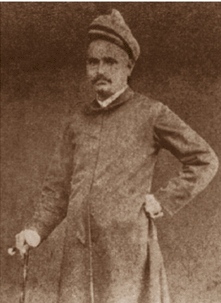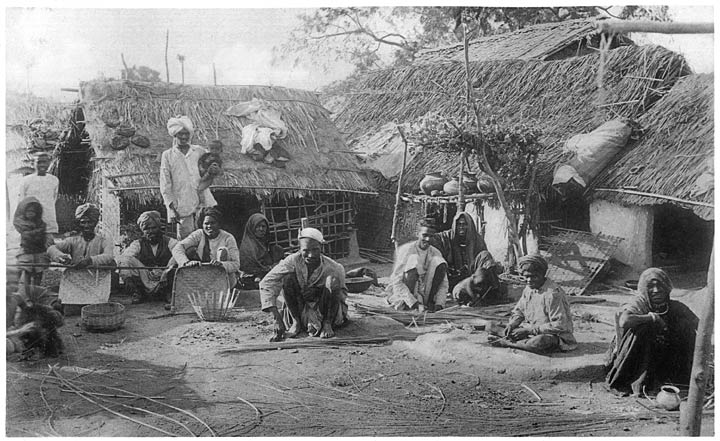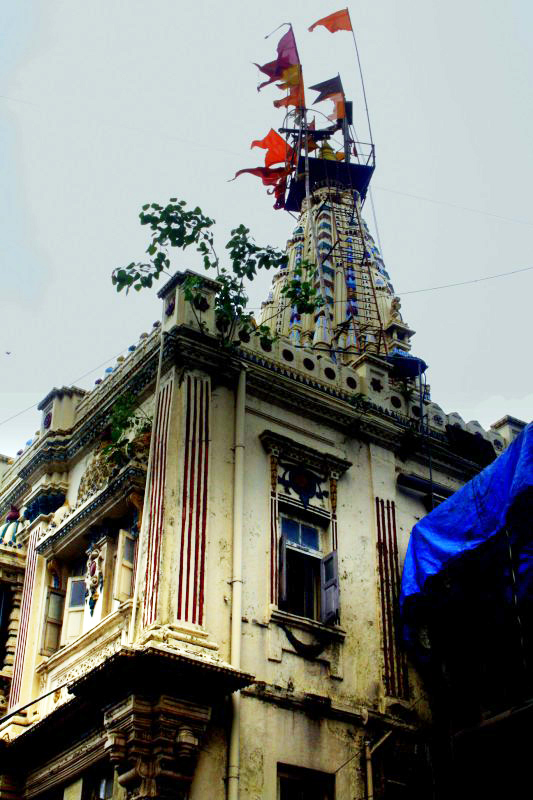 |
Sakharam Arjun
Sakharam Arjun (sometimes Sakharam Arjun Ravut in official documents but he did not use the caste-linked surname in publications) (1839-16 April 1885) was an eminent physician and social activist in Bombay. An expert on Indian medicinal plants, he was one of the two Indian founding members of the Bombay Natural History Society. He became the step-father of the pioneering woman physician Rukhmabai (1864-1955) after he married her widowed mother Jayantibai. He also wrote books in Marathi. Biography Arjun was born in Mumbai and lost both his parents by 1850. Arjun studied at Elphinstone Institution and joined Grant Medical College as a Stipendiary Student in 1858. His tutor was Narayan Daji, brother of Bhau Daji. Arjun received a Licentiate of Medicine from the Bombay University in 1863. He joined to teach medical botany and was made an assistant, the first Indian in the position, to William Guyer Hunter. He worked at the Jamsetjee Jeejeebhoy Hospital and was for sometime in char ... [...More Info...] [...Related Items...] OR: [Wikipedia] [Google] [Baidu] |
 |
Caste
Caste is a form of social stratification characterised by endogamy, hereditary transmission of a style of life which often includes an occupation, ritual status in a hierarchy, and customary social interaction and exclusion based on cultural notions of purity and pollution. * Quote: "caste ort., casta=basket ranked groups based on heredity within rigid systems of social stratification, especially those that constitute Hindu India. Some scholars, in fact, deny that true caste systems are found outside India. The caste is a closed group whose members are severely restricted in their choice of occupation and degree of social participation. Marriage outside the caste is prohibited. Social status is determined by the caste of one's birth and may only rarely be transcended." * Quote: "caste, any of the ranked, hereditary, endogamous social groups, often linked with occupation, that together constitute traditional societies in South Asia, particularly among Hindus in India. Although ... [...More Info...] [...Related Items...] OR: [Wikipedia] [Google] [Baidu] |
.jpg) |
Bombay Natural History Society
The Bombay Natural History Society (BNHS), founded on 15 September 1883, is one of the largest non-governmental organisations in India engaged in conservation and biodiversity research. It supports many research efforts through grants and publishes the '' Journal of the Bombay Natural History Society''. Many prominent naturalists, including the ornithologists Sálim Ali and S. Dillon Ripley, have been associated with it. History British hunters in Bombay organized a hunting group around 1811, their activities included riding with foxhounds and shooting. A Bombay Hunt was supported by Sir Bartle Frere from 1862. A natural history society was begun, possibly as spinoff from the Bombay Geographical Society, in 1856 by Doctors Don (of Karachee), Andrew Henderson Leith (surgeon), George Buist, and Henry John Carter along with Lawrence Hugh Jenkins, then a registrar of the Supreme Court. The group did not last more than three years. On 15 September 1883 eight men interested in ... [...More Info...] [...Related Items...] OR: [Wikipedia] [Google] [Baidu] |
|
Rukhmabai
Rukhmabai (22 November 1864 – 25 September 1955) was an Indian physician and feminist. She is best known for being one of the first practicing women doctors in colonial India as well as being involved in a landmark legal case involving her marriage as a child bride between 1884 and 1888. The case raised significant public debate across several topics, which most prominently included law vs tradition, social reform vs conservatism and feminism in both British-ruled India and England. This ultimately contributed to the '' Age of Consent Act'' in 1891. Early life Rukhmabai was born to Janardhan Pandurang and Jayantibai in a Marathi family. Her father passed away when she was aged two and her mother seventeen. Six years after her husband's demise, Jayantibai married the widower Sakharam Arjun, an eminent physician and social activist in Bombay. Remarriage of widows was permitted among the ''Suthar'' (carpenter) community - the caste to which Rukhmabai's mother belonged. Two ... [...More Info...] [...Related Items...] OR: [Wikipedia] [Google] [Baidu] |
|
 |
Bombay Drugs
Mumbai (, ; also known as Bombay — the official name until 1995) is the capital city of the Indian state of Maharashtra and the ''de facto'' financial centre of India. According to the United Nations, as of 2018, Mumbai is the second-most populous city in India after Delhi and the eighth-most populous city in the world with a population of roughly 20 million (2 crore). As per the Indian government population census of 2011, Mumbai was the most populous city in India with an estimated city proper population of 12.5 million (1.25 crore) living under the Brihanmumbai Municipal Corporation. Mumbai is the centre of the Mumbai Metropolitan Region, the sixth most populous metropolitan area in the world with a population of over 23 million (2.3 crore). Mumbai lies on the Konkan coast on the west coast of India and has a deep natural harbour. In 2008, Mumbai was named an alpha world city. It has the highest number of millionaires and billionaires among all cities ... [...More Info...] [...Related Items...] OR: [Wikipedia] [Google] [Baidu] |
 |
Grant Medical College
The Grant Government Medical College, Mumbai, is a public medical college, affiliated to the Maharashtra University of Health Sciences. Founded in 1845, it is one of the oldest institutions teaching medicine in South Asia. Its clinical affiliate is Sir Jamsetjee Jeejebhoy Group of Hospitals: a conglomerate of four hospitals in South Bombay including the Sir J. J. Hospital, St George Hospital, Gokuldas Tejpal Hospital, and Cama and Albless Hospital (women and children hospital). History Establishment of Grant Medical College The Bombay Presidency became part of the British possessions in India in 1818. In Western India there was a need for well-trained doctors as well as a general hospital for Indians . Under the guidance of Mountstuart Elphinstone attempts were made to offer Indians an opportunity to learn and practice Medicine along western lines. In 1826, a medical school was started with surgeon John McLennan as the superintendent of the Indian (native) medical ... [...More Info...] [...Related Items...] OR: [Wikipedia] [Google] [Baidu] |
 |
Bhau Daji
Ramachandra Vitthal Lad (1824–1874), commonly known as Bhau Daji Lad was an Indian physician, Sanskrit scholar, and an antiquarian. Early life and education Lad was born in 1822 in a Gaud Saraswat Brahmin family in Mandrem (Manjari) Goa. An Englishman, noticing his acumen at chess convinced his father to give the boy an English education. Bhau moved to Mumbai and completed his schooling at the Elphinstone Institution. Around this time he won a prize for writing an essay on infanticide, and was appointed a teacher in the Elphinstone Institution. He then studied medicine at the Grant Medical College. He belonged to the class of 1850, the first graduating batch of the college. Medical career In 1851, he started practising medicine in Mumbai and became very successful. He studied the Sanskrit literature of medicine. He also tested the value of drugs to which the ancient Hindus had ascribed marvellous powers, among other pathological subjects of historical interest investigat ... [...More Info...] [...Related Items...] OR: [Wikipedia] [Google] [Baidu] |
 |
William Guyer Hunter
Sir William Guyer Hunter, (1829 – 14 March 1902) was a British surgeon-general in India, principal of medical colleges and Conservative politician. He took part in official enquiries into vaccination and cholera. Life Hunter was born at Calcutta, India and was educated at King's College London and Aberdeen University. He began his training at Charing Cross Hospital in 1844 at the same time as Thomas Henry Huxley and Joseph Fayrer, and passed, in 1850, into the Bombay medical department as an assistant-surgeon. He became Principal of Grant Medical College in 1866, a post he held for ten years. He was appointed Vice Chancellor of Bombay University in 1880 by Sir Richard Temple. He returned to London and was a member of the Royal Commission on Vaccination which was initiated in 1879 and sat for seven years. Hunter was surgeon to the Queen in 1881. In 1883 there was an outbreak of cholera in Egypt which had fallen under British jurisdiction in the previous year. There was an ... [...More Info...] [...Related Items...] OR: [Wikipedia] [Google] [Baidu] |
|
Hydnocarpus Wightiana
''Hydnocarpus wightianus'' or chaulmoogra is a tree in the Achariaceae family. ''Hydnocarpus wightiana'' seed oil has been widely used in traditional Indian medicine, especially in Ayurveda, and in Chinese traditional medicine for the treatment of leprosy. It entered early Western medicine in the nineteenth century before the era of sulfonamides and other antibiotics for the treatment of several skin diseases and leprosy. The oil was prescribed for leprosy as a mixture suspended in gum or as an emulsion. Common names Common name: Jangli almond * Hindi: कालमोगरा Calmogara, Chalmogra, Chaulmoogra, Jangli badam * Kannada: Chalmogra yenne mara, Mirolhakai, Surti, Suranti, Toratti, Garudaphala * Malayalam: Kodi, Maravatty, Marotti, Nirvatta, Nirvetti * Marathi: Kadu Kawath * Sanskrit: Tuvaraka, Turveraka, Tuvrak, कुष्टवैरी Kushtavairi * Tamil: Maravetti, Maravattai, Marotti * Telugu: Niradi-vittulu Habitat In India: It grows in tropical forests al ... [...More Info...] [...Related Items...] OR: [Wikipedia] [Google] [Baidu] |
|
 |
Edith Pechey Phipson
Mary Edith Pechey (7 October 1845 – 14 April 1908) was one of the first women doctors in the United Kingdom and a campaigner for women's rights. She spent more than 20 years in India as a senior doctor at a women's hospital and was involved in a range of social causes. Family and Edinburgh Mary Edith Pechey was born in Langham, Essex, to Sarah (''née'' Rotton), a lawyer's daughter who, unusually for a woman of her generation, had studied Greek, and William Pechey, a Baptist minister with an MA in theology from the University of Edinburgh. After being educated by her parents, she worked as governess and teacher until 1869. Lutzker notes that "Her mother also was competent in Greek and other studies and both parents possessed - along with their questing nonconformist minds - a deep and serious love of learning." The Campaign to study medicine After Sophia Jex-Blake's sole application to study medicine at the University of Edinburgh was turned down, she advertised in Th ... [...More Info...] [...Related Items...] OR: [Wikipedia] [Google] [Baidu] |
 |
Atmaram Pandurang
Atmaram Pandurang or Atmaram Pandurang Turkhadekar (or just Turkhad in English publications) (1823 – 26 April 1898) was an Indian physician and social reformer who founded the Prarthana Samaj and was one of the two Indian co-founders (the other being Sakharam Arjun) of the Bombay Natural History Society. A graduate of Grant Medical College, he was a brother of Dadoba Pandurang (9 May 1814 – 17 October 1882), a scholar of Sanskrit and Marathi. Atmaram Pandurang served briefly as sheriff of Bombay in 1879. Atmaram was born to Pandurang Yeshwant and Yashodabai. He went to the Elphinstone Institution (along with fellow student Dadabhai Naoroji) where he studied mathematics under Bal Gangadhar Shastri Jambhekar (1812-1846). He then joined the newly opened Grant Medical College and was in the first batch of students that included Dr Bhau Daji Lad and joined on 1 November 1845.With a diploma, he worked in Bhiwandi, running a smallpox vaccination campaign. He later helped frame Art ... [...More Info...] [...Related Items...] OR: [Wikipedia] [Google] [Baidu] |
 |
19th-century Indian Medical Doctors
The 19th (nineteenth) century began on 1 January 1801 ( MDCCCI), and ended on 31 December 1900 ( MCM). The 19th century was the ninth century of the 2nd millennium. The 19th century was characterized by vast social upheaval. Slavery was abolished in much of Europe and the Americas. The First Industrial Revolution, though it began in the late 18th century, expanding beyond its British homeland for the first time during this century, particularly remaking the economies and societies of the Low Countries, the Rhineland, Northern Italy, and the Northeastern United States. A few decades later, the Second Industrial Revolution led to ever more massive urbanization and much higher levels of productivity, profit, and prosperity, a pattern that continued into the 20th century. The Islamic gunpowder empires fell into decline and European imperialism brought much of South Asia, Southeast Asia, and almost all of Africa under colonial rule. It was also marked by the collapse of the lar ... [...More Info...] [...Related Items...] OR: [Wikipedia] [Google] [Baidu] |